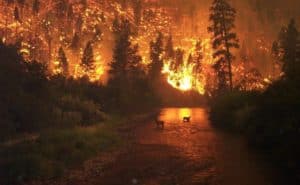
Alaska fires now cover 550,000 acres
Credit: Wikimedia Commons
The planet’s far North is burning. This summer, over 600 wildfires have consumed more than 2.4 million acres of forest across Alaska. Fires are also raging in northern Canada. In Siberia, choking smoke from13 million acres — an area nearly the size of West Virginia — is blanketing towns and cities.
Fires in these places are normal. But, as studies here at the University of Alaska’s International Arctic Research Center show, they are also abnormal.
My colleagues and I are examining the complex relationships between warming climate, increasing fire and shifting patterns of vegetation. Using locally focused climate data and models from the Scenarios Network for Alaska and Arctic Planning, the research group I help coordinate, we are finding evidence that is deeply worrying — not just for those of us who live within the fires’ pall of smoke, but for the world.
Recent fires are too frequent, intense and severe. They are reducing older-growth forest in favor of young vegetation, and pouring more carbon into the atmosphere at a time when carbon […]










